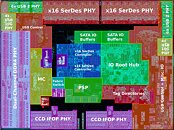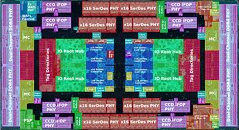- Joined
- Oct 9, 2007
- Messages
- 47,591 (7.45/day)
- Location
- Dublin, Ireland
| System Name | RBMK-1000 |
|---|---|
| Processor | AMD Ryzen 7 5700G |
| Motherboard | Gigabyte B550 AORUS Elite V2 |
| Cooling | DeepCool Gammax L240 V2 |
| Memory | 2x 16GB DDR4-3200 |
| Video Card(s) | Galax RTX 4070 Ti EX |
| Storage | Samsung 990 1TB |
| Display(s) | BenQ 1440p 60 Hz 27-inch |
| Case | Corsair Carbide 100R |
| Audio Device(s) | ASUS SupremeFX S1220A |
| Power Supply | Cooler Master MWE Gold 650W |
| Mouse | ASUS ROG Strix Impact |
| Keyboard | Gamdias Hermes E2 |
| Software | Windows 11 Pro |
Here are the first detailed die maps of the I/O controller dies of AMD's "Matisse" and "Rome" multi-chip modules that make up the company's 3rd generation Ryzen and 2nd generation EPYC processor families, respectively, by PC enthusiast and VLSI engineer "Nemez" aka @GPUsAreMagic on Twitter, with underlying die-shots by Fitzchens Fitz. The die maps of the "Matisse" cIOD in particular give us fascinating insights to how AMD designed the die to serve both as a cIOD and as an external FCH (AMD X570 and TRX40 chipsets). At the heart of both these chips' design effort is using highly configurable SerDes (serializer/deserializers) that can work as PCIe, SATA, USB 3, or other high-bandwidth serial interfaces, using a network of fabric switches and PHYs. This is how motherboard designers are able to configure the chipsets for the I/O they want for their specific board designs.
The "Matisse" cIOD has two x16 SerDes controllers and an I/O root hub, along with two configurable x16 SerDes PHYs, while the "Rome" sIOD has four times as many SerDes controllers, along with eight times as many PHYs. The "Castle Peak" cIOD (3rd gen Ryzen Threadripper) disables half the SerDes resources on the "Rome" sIOD, along with half as many memory controllers and PHYs, limiting it to 4-channel DDR4. The "Matisse" cIOD features two IFOP (Infinity Fabric over Package) links, wiring out to the two "Zen 2" CCDs (chiplets) on the MCM, while the "Rome" sIOD features eight such IFOP interfaces for up to eight CCDs, along with IFIS (Infinity Fabric Inter-Socket) links for 2P motherboards. Infinity Fabric internally connects all components on both IOD dies. Both dies are built on the 12 nm FinFET (12LP) silicon fabrication node at GlobalFoundries.


View at TechPowerUp Main Site
The "Matisse" cIOD has two x16 SerDes controllers and an I/O root hub, along with two configurable x16 SerDes PHYs, while the "Rome" sIOD has four times as many SerDes controllers, along with eight times as many PHYs. The "Castle Peak" cIOD (3rd gen Ryzen Threadripper) disables half the SerDes resources on the "Rome" sIOD, along with half as many memory controllers and PHYs, limiting it to 4-channel DDR4. The "Matisse" cIOD features two IFOP (Infinity Fabric over Package) links, wiring out to the two "Zen 2" CCDs (chiplets) on the MCM, while the "Rome" sIOD features eight such IFOP interfaces for up to eight CCDs, along with IFIS (Infinity Fabric Inter-Socket) links for 2P motherboards. Infinity Fabric internally connects all components on both IOD dies. Both dies are built on the 12 nm FinFET (12LP) silicon fabrication node at GlobalFoundries.


View at TechPowerUp Main Site





